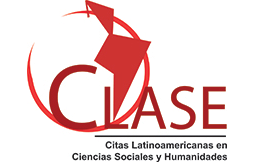The The CBCL/6-18 Scale in Brazil: Exploratory Studies on Evidence of Validity and Accuracy
DOI:
https://doi.org/10.20435/pssa.v1i1.3000Keywords:
child psychopathology, psychometrics, psychological assessmentAbstract
Introduction: The Childhood and Adolescent Behavior Inventory 6-18 (CBCL/6-18) aims to assess behavioral problems and social competence of children and adolescents aged 6 to 18 years, as assessed by their parents. Due to the scarcity of psychometric studies in Brazil, the objective of this study was to conduct them. Analyses considered representative of the search for evidence of validity based on content (EVC), relationships with external variables (EVE) and internal structure and precision (EVI) were adopted. Method: three expert judges participated in the EVC, and the data were analyzed using Fleiss' Kappa. For EVE, the sample consisted of 94 parents of children and adolescents, one group without behavioral complaints and the other with intellectual disabilities (GDI). Differences between the responses of the two groups were tested using the t-test. For EVI, there was a sample of 202 parents from different types of schools, to whom Confirmatory Factor Analysis was administered. Results: satisfactory results were found for the EVE, with differences between the groups, but not so satisfactory for the EVC and EVI. Discussion: in the EVE, the groups differed due to the diagnostic description of the GDI itself. The EVC identified items that presented generic writing and low quality in writing. In the EVI, there were mainly unacceptable adjustment indices for the model, with indications of exploratory factor analyses in the country. Conclusion: these results support certain evidence of validity of the instrument, but also reinforce the continuity of its investigations.
References
Achenbach, T. M. (1991). Manual for the Child Behavior Checklist/4-18 and 1991 profile. University of Vermont.
Achenbach, T. M. (2001). Manual for the Child Behavior Checklist and 1991 profile. University of Vermont. DOI: https://doi.org/10.1037/t47452-000
Achenbach, T. M., & Edelbrock, C. S. (1983). Manual for the Child Behavior Checklist and Revised Child Behavior Profile. University of Vermont.
Achenbach, T. M., & Rescorla, L. A. (2001). Manual for the ASEBA School-Age Forms & Profiles. University of Vermont.
American Educational Research Association, American Psychological Association, & National Council on Measurement in Education. (2014). Standards for educational and psychological testing. AERA.
American Psychiatric Association [APA]. (2014). Manual diagnóstico e estatístico de transtornos mentais: DSM-5. (5ª ed.). Artmed.
Bandeira, D. R., Borsa, J. B., Arteche, A. X., & Segabinazi, J. D. (2010). Avaliação de problemas de comportamento infantil através do Child Behavior Checklist (CBCL). In C. S. Hutz (Org.), Avanços em Avaliação Psicológica e Neuropsicológica de crianças e adolescentes (pp. 101–122). Casa do Psicólogo.
Bollen, K. A. (1989). Structural Equations with Latent Variables. John Wiley and Sons, Inc., New York. https://doi.org/10.1002/9781118619179 DOI: https://doi.org/10.1002/9781118619179
Bordin, I. A. S, Mari, J. J., & Caeiro, M. F. (1995). Validação da versão brasileira do Child Behavior Checklist (CBCL) (Inventário de Comportamentos da Infância e Adolescência): Dados preliminares. Revista da Associação Brasileira de Psiquiatria–Asociación Psiquiatrica de la America Latina, 17(2), 55–66. https://www.researchgate.net/publication/285968522_Validation_of_the_Brazilian_version_of_the_Child_Behavior_Checklist_CBCL
Bordin, I. A. S., Rocha, M. M., Paula, C. S., Teixeira, M. C. T. V., Achenbach, T. M., Rescorla, L. A., & Silvares, E. F. M. (2013). Child Behavior Checklist (CBCL), Youth Self-Report (YSR) e Tache’s Report Form (TRF): Uma visão geral sobre o desenvolvimento das versões originais e brasileiras. Cadernos de Saúde Pública, 29(1), 13–28. https://doi.org/10.1590/S0102-311X201300010004 DOI: https://doi.org/10.1590/S0102-311X2013000100004
Bordin, I. A. S., Silvares, E. F. de M., Rocha, M. M., Teixeira, M. C. T. V., & Paula, C. S. (2010). Inventário de Comportamentos da Infância e adolescência (CBCL 6/18). ASEBA.
Borsa, J. C., & Bandeira, D. R. (2011). Uso de instrumentos psicológicos de avaliação do comportamento agressivo infantil: Análise da produção científica brasileira. Avaliação Psicológica, 10(2), 193¬–203. http://pepsic.bvsalud.org/scielo.php?script=sci_arttext&pid=S1677-04712011000200010&lng=pt&nrm=iso&tlng=pt
Borsa J. C., & Nunes M. L. T. (2008). Concordância parental sobre problemas de comportamento infantil através do CBCL. Paidéia, 18, 317–330. https://doi.org/10.1590/S0103-863X2008000200009 DOI: https://doi.org/10.1590/S0103-863X2008000200009
Byrne, B. M. (2016). Structural equation modeling with Amos: Basic concepts, applications, and programming (3ª ed.). Routledge. DOI: https://doi.org/10.4324/9781315757421
Coffman, D. L., & MacCallum, R. C. (2005). Using parceling to increase statistical power in structural equation modeling. In T. A. Little, J. A. Schnabel, & J. A. Baumert (Eds.), Modeling longitudinal and multiple group data: Practical issues, applications, and recommendations (pp. 235–255). Lawrence Erlbaum Associates.
Cohen, J. (1988). Statistical power analysis for the behavioral sciences (2ª ed.). Lawrence Erlbaum Associates.
Cronk, B. C. (2017). How to use SPSS: A step-by-step guide to analysis and interpretation (8ª ed.). Routledge. DOI: https://doi.org/10.4324/9781315142999
Damásio, B. F. (2012). Uso da análise fatorial exploratória em psicologia. Avaliação Psicológica, 11(2), 213–228. http://pepsic.bvsalud.org/scielo.php?script=sci_arttext&pid=S1677-04712012000200007&lng=pt&tlng=pt
De Vellis, R. F. (2003). Scale Development: Theory and Applications (2ª ed., Vol. 26). Sage Publications.
Duarte, C. S., & Bordin, I. A. (2000). Instrumentos de avaliação. Brazilian Journal of Psychiatry, 22, 55–58. https://doi.org/10.1590/S1516-44462000000600015 DOI: https://doi.org/10.1590/S1516-44462000000600015
Frizzo, G. B., Pedrini, J. R. de Souza, D. S., Bandeira, D. R., & Borsa, J. C. (2015). Reliability of child behavior checklist and teacher’s report form in a sample of brazilian children. Universitas Psychologica, 14(1), 149–156. https://doi.org/10.11144/Javeriana.upsy14-1.rcbc DOI: https://doi.org/10.11144/Javeriana.upsy14-1.rcbc
Gauy, F. V., & Guimarães, S. S. (2006). Triagem em saúde mental infantil. Psicologia: Teoria e Pesquisa, 22, 5–16. https://doi.org/10.1590/S0102-37722006000100002 DOI: https://doi.org/10.1590/S0102-37722006000100002
Hair, J. F., Black, W. C., Babin, B. J., Anderson, R. E., & Tatham, R. E. (2009). Análise Multivariada de Dados (6ª ed., 147 p). Bookman.
Hu, L. T., & Bentler, P. M. (1998). Fit indices in covariance structure modeling: Sensitivity to underparameterized model misspecification. Psychological Methods, 3(4), 424–453. https://doi.org/10.1037/1082-989X.3.4.424 DOI: https://doi.org/10.1037//1082-989X.3.4.424
IBM Corp. Released (2012). IBM SPSS Statistics for Windows, Version 21.0. IBM Corp.
Kolenikov, S., & Bollen, K. A. (2012). Testing negative error variances: Is a Heywood case a symptom of misspecification? Sociological Methods & Research, 41(1), 124–167. https://doi.org/10.1177/0049124112442138 DOI: https://doi.org/10.1177/0049124112442138
Martin, C., & Savage-McGlynn, E. (2013). A “good practice” guide for the reporting of design and analysis for psychometric evaluation. Journal of Reproductive and Infant Psychology, 31(5), 449–455. https://doi.org/10.1080/02646838.2013.835036 DOI: https://doi.org/10.1080/02646838.2013.835036
Massola, M. C., & Silvares, E. B. (2005). Análise das escalas sindrômicas do CBCL/6-18: Uma revisão crítica. Psicologia: Teoria e Pesquisa, 21(4), 297–309. https://doi.org/10.1590/S0102-37722005000400005
Microsoft Corporation. (2018). Microsoft Excel. https://office.microsoft.com/excel
Pasquali, L. (1998). Psicometria: Teoria e aplicações. Vozes.
Pasquali, L. (2010). Psicometria: Teoria e aplicações (2ª ed.). Vozes.
R Development Core Team. (2017). R: A language and environment for statistical computing. R Foundation for Statistical Computing. https://www.R-project.org
Roama-Alves, R. J., & Amorim, R. D. M. (2023). O Inventário CBCL/6-18 no Brasil: Revisão de Evidências de Validade e Precisão. Avaliação Psicológica, 22(1), 33–41. https://doi.org/10.15689/ap.2023.2201.21503.04
Rocha M. M., Rescorla, L. A., Emerich, D. R. Silvares, E. F., Borsa, J. C., Araújo, L. G., Bertolla, M. H., Oliveira, M. S., Perez, N. C., Freitas, P. M., & Assis, S. G. (2013). Behavioural/emotional problems in Brazilian children: Findings from parents' reports on the Child Behavior Checklist. Epidemiology and Psychiatric Sciences. 22(4), 329–338. https://doi.org/10.1017/S2045796012000637 DOI: https://doi.org/10.1017/S2045796012000637
Rodrigues, E. C., & Alchieri, J. C. (2009) Avaliação das características de afetividade em crianças e jovens com síndrome de Down. Psico-USF, 14(1), 107–116. https://pepsic.bvsalud.org/scielo.php?script=sci_abstract&pid=S1413-82712009000100011 DOI: https://doi.org/10.1590/S1413-82712009000100011
Rodríguez, E. R. (2004). Programa de educación emocional para niños y jóvenes com síndrome de Down. Revista Síndrome de Down, 21, 84-93. http://revistadown.downcantabria.com/wp-content/uploads/2004/09/revista82_84-93.pdf
Sato, M. (1987). Métodos de análise fatorial em psicologia. EdUSP.
Silvares, E. F. M., Meyer, S. B., Santos, E. O., & Gerencer, T. T. (2006). Um estudo em cinco clínicas-escola brasileiras com a lista de verificação comportamental para criança (CBCL). In E. F. M., Silvares (Org.), Atendimento Psicológico em Clínicas-Escola (pp. 59–72). Alínea.
Taber, K. S. (2018). The use of cronbach’s alpha when developing and reporting research instruments in science education. Research in Science Education, 48(6), 1273–1296. https://link.springer.com/article/10.1007/s11165-016-9602-2 DOI: https://doi.org/10.1007/s11165-016-9602-2
Urbina, S. (2014). Essentials of psychological testing. John Wiley & Sons. DOI: https://doi.org/10.1002/9781394259458
Published
How to Cite
Issue
Section
License

This work is licensed under a Creative Commons Attribution 4.0 International License.
The articles published on journal Psicologia e Saúde holds the copyrights of all texts published by it. Due to that, there is a demand for a letter of copyright cession (see Appreciation). The full reproduction of any article of this Journal in other publications, by any means, requires a written authorization of the Editorial Board. Partial reproductions of articles (abstracts, more than 500 words of text, tables, pictures and other illustrations, sound files) should have the written permission of the Editorial Board and the Authors.












